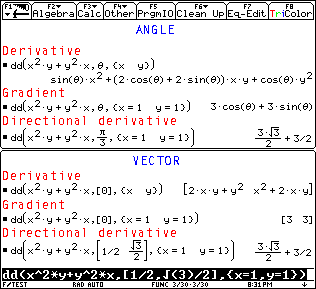Note: This function is still being developed and may have errors.

dd(Expr,AngleOrVector,VarPointList)
Expr: A continuous function.
AngleOrVector: A vector matrix or an angle. A vector is a one dimensional matrix, either row ([x,y]) or column ([x;y]). It can be the zero vector ([0], [0;0], [0,0,0], etc.). The angle can be in either degrees or radians if the appropriate symbol is used ( ° , r ), or in the default unit if no symbol is used, or it can be an undefined variable.
VarPointList: Must list all variables, {x, y,...}, and may indicate the point of evaluation, {x=Px, y=Py,...}.
Return value:
The derivative: If AngleOrVector is a zero vector, [0],
or evaluates to a variable, and VarPointList does not include the
point. If AngleOrVector is a vector, the derivative will be returned
as a vector.
The gradient: If AngleOrVector is a zero vector, [0], or evaluates to a variable, and VarPointList includes the point. If AngleOrVector is a vector, the gradient will be returned as a vector.
The directional derivative: If AngleOrVector is an angle or a non-zero vector.
Examples:
ANGLE
1. dd(x2y+xy2,u,{x,y)) Derivative
x2 sin(u)+2xy(cos(u)+sin(u))+cos(u)y2
2. dd(x2y+xy2,u,{x=1,y=1)) Gradient
3 cos(u)+3 sin(u)
3. dd(x2y+xy2,pi/3,{x=1,y=1)) Directional derivative
3*sqrt(3)/2+3/2
VECTOR
1. dd(x2y+xy2,[0],{x,y)) Derivative
[2xy+y2 ,
x2+2xy]
2. dd(x2y+xy2,[0],{x=1,y=1)) Gradient
[3 , 3]
3. dd(x2y+xy2,[1/2 , sqrt(3)/2],{x=1,y=1)) Directional
derivative
3*sqrt(3)/2+3/2
4. dd(x2y+xy2-z,[1, 1, 0],{x=1,y=1,z=0)) Directional
derivative
3*sqrt(2)